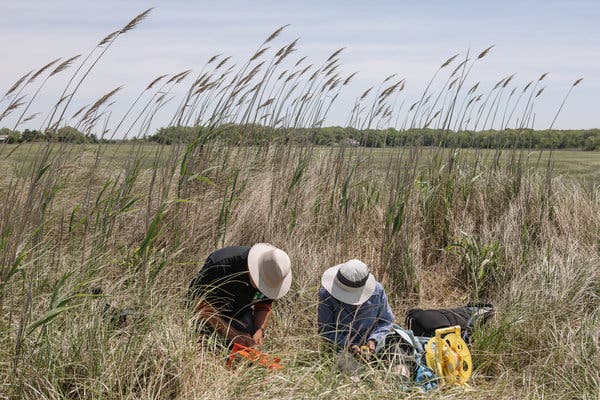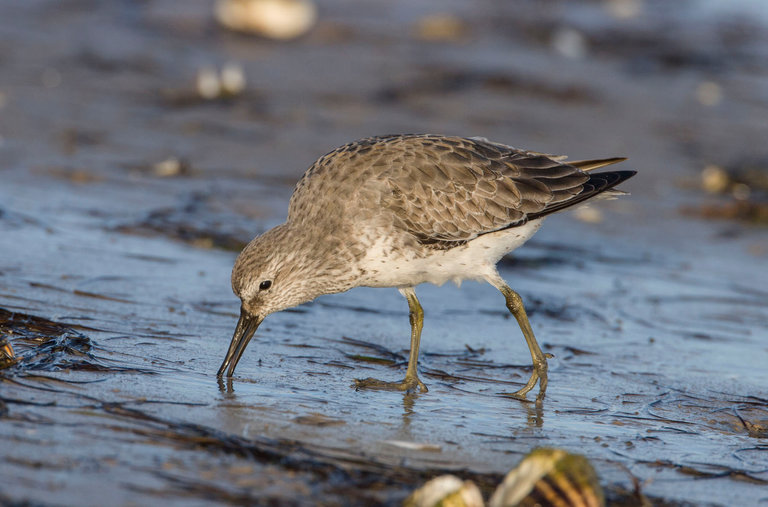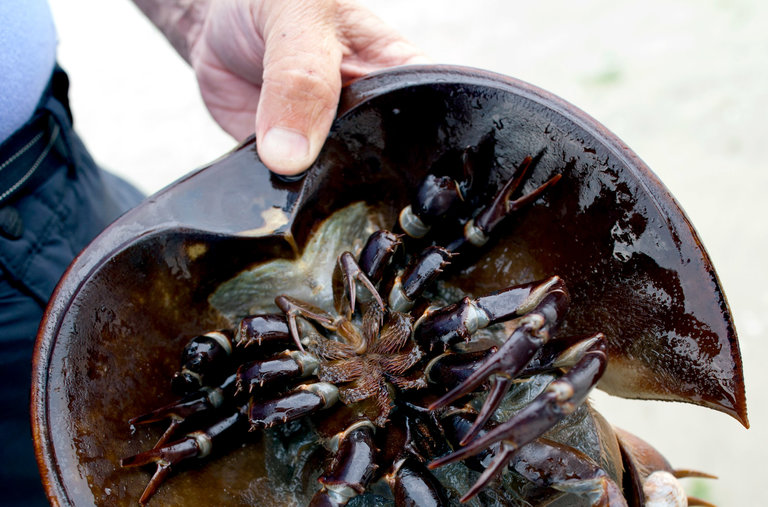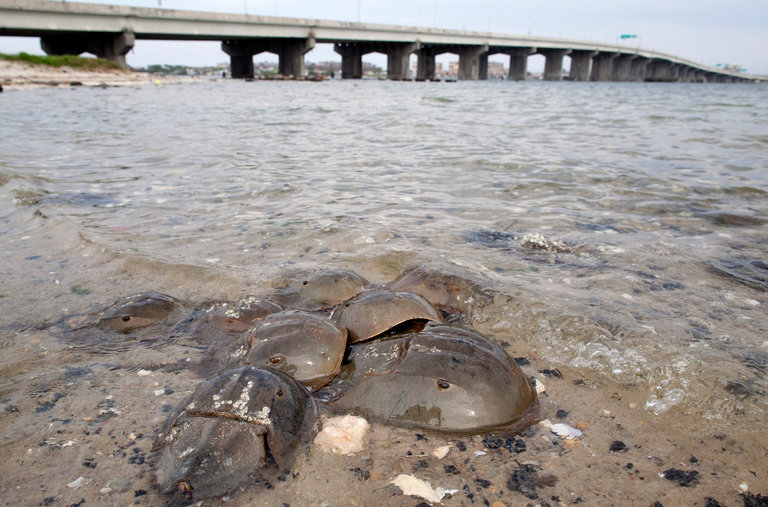REEDS BEACH, N.J. — On a recent spring day at this remote beach, hundreds of shorebirds flapped frantically beneath a net trapping them on the sand. Dozens of volunteers rushed to disentangle the birds and place them gently in covered crates.
On a nearby sand dune, teams of scientists and volunteers attached metal leg bands, plastic tags and tiny radio transmitters to birds of three species. They were weighed and measured, and then released.
The operation is part of an annual “catch” of migratory shorebirds that stop on the beaches of the Delaware Bay, a globally important bird habitat, to gorge on the eggs of spawning horseshoe crabs. The stopover strengthens the birds for the long-distance migration to the Canadian Arctic, their breeding grounds, from as far away as southern Chile.
With fresh information on the birds’ weight and health, the scientists will be able to judge whether these species are getting enough food to reach their breeding grounds, and whether their populations are stable.
One of them, the red knot, has been listed as a threatened species. Since 2000, red knot numbers have plunged as low as 10,000 in some years, around one-ninth of the level in the 1980s. At the moment, the population hovers at about 30,000, still too low to be sustainable, conservationists claim.
[Like the Science Times page on Facebook. | Sign up for the Science Times newsletter.]
Additional challenges like severe Arctic weather during breeding, or coastal development along the migration route, could lead to the bird’s extinction. Populations of other migratory shorebirds, like semipalmated sandpipers and ruddy turnstones, have also declined.
The problem, conservationists say, is the overfishing of horseshoe crabs for commercial fishery bait and the harvesting of the animals for their blood, which contains an extract called L.A.L., used by the biomedical industry to detect certain bacteria.

Volunteers, Charles Duncan, left, and Susan Taylor, preparing nets to trap shorebirds for examination.
Now, conservationists are renewing calls to halt the harvest for bait altogether, and to persuade the biomedical industry to switch to recombinant Factor C (rFC), a synthetic alternative to LAL, to ease pressure on the horseshoe crab population.
“The only responsible thing to do here is a moratorium,” said Eric Stiles, president of New Jersey Audubon, an environmental group leading the initiative.
Recognizing the threat to the birds, the Atlantic States Marine Fisheries Commission, an interstate regulator, banned the harvest of female horseshoe crabs for bait starting in 2013, in the hope that a recovering population of females would lay more eggs and allow the birds to rebound.
While the commission maintains there has been an increase in the number of crabs since the ban, neither the crabs nor the red knot have recovered to the levels seen before the fishing industry’s unprecedented removal of the crabs from the bay in the 1990s.
The commission’s critics blame poor enforcement of the ban and the continued harvest of thousands of crabs for bleeding, which is estimated to kill at least 15 percent of them and may prevent the survivors from reproducing.
Crabs taken for bleeding are not included in the commission’s quotas, and their numbers and mortality rates are not published because the companies that collect the blood want the figures kept confidential.
Conservation groups are urging officials in Delaware, Maryland and Virginia — three bay states that use crab quotas — to ban the horseshoe crab harvest until there’s a full recovery of both crabs and birds. (New Jersey, the other state bordering the bay, imposed a moratorium in 2008.)
Banning the harvest, advocates argue, would rebuild a crab population that is essential not only to the birds but also to depleted marine species, such as weakfish, that feed on the crabs and in turn support commercial and recreational fishing on the bay.
“It’s not just about the birds,” said David Mizrahi, vice president for research and monitoring at New Jersey Audubon. “It’s about the whole ecosystem.”
Within the knot population, the biggest decline has been seen in long-distance migrants that spend the northern winter in Tierra del Fuego, in southern Chile. That population numbered only 9,840 in 2018, down 25 percent in the last year and less than a fifth of the number in 2000.
Scientists say those birds are especially sensitive to a shortage of horseshoe crab eggs on Delaware Bay beaches, as they are emaciated when they arrive from South America.
In the biomedical industry, the switch to rFC is being led by the pharmaceutical company Eli Lilly, which began using the substance to test new products in 2016 and plans to have 90 percent of the changeover completed by the end of 2020, according to Jay Bolden, a senior consultant biologist for the company.
The synthetic alternative is comparable in cost and efficacy to LAL, he added.
For now, conservationists say a sharp decline in crab eggs shows that quotas have failed to restore the female crab population. Average egg densities on five New Jersey beaches dropped to between 2,000 and 7,000 eggs per square meter in 2017 from as much as 100,000 per square meter in 1991, according to New Jersey Audubon.
But the fisheries commission argues that its quotas for the crab bait harvest have stabilized the populations of red knots and other shorebirds, and are beginning to result in increasing numbers of female crabs in the bay.
The number of mature female crabs rose to 7.8 million in 2017 from 5.4 million in 2011 before the quota system began, according to commission data.
The tally isn’t close to the 11.2 million females — or 80 percent of the bay’s carrying capacity — that might lead the commission to permit the female crab harvest to resume. But officials say it shows the current quota is working.
“I’m not sure what more the commission could do in terms of restricting harvest beyond there being zero females” allowed under the quota, said Mike Schmidtke, the commission’s fishery management plan coordinator. (This year, the commercial fishing industry is allowed to take 500,000 male crabs from the bay.)
The commission estimates the red knot population to have been in the 43,000 to 49,000 range since 2011, based on a statistical method that differs from one used by conservationists.
That number, too, is well below the 81,900 that would allow the commission to lift its ban on harvesting female crabs, but is at least broadly stable, Dr. Schmidtke said.
Larry Niles, an independent biologist who has led the annual shorebird catch on the New Jersey side of the bay for the last 23 years, dismissed as “utter nonsense” Dr. Schmidtke’s assertion that there was nothing more the commission could do to boost the number of crab eggs on the beaches.
And the commission’s claim that the number of female horseshoe crabs is increasing is not supported by the number of horseshoe crab eggs, he added.
“If there was an increase, it would show up in egg densities,” Dr. Niles said.




